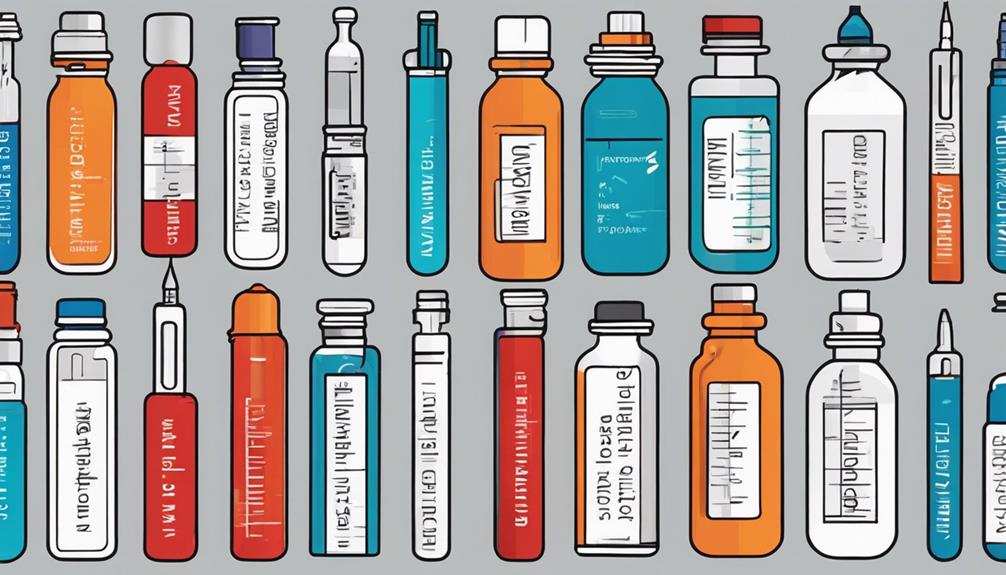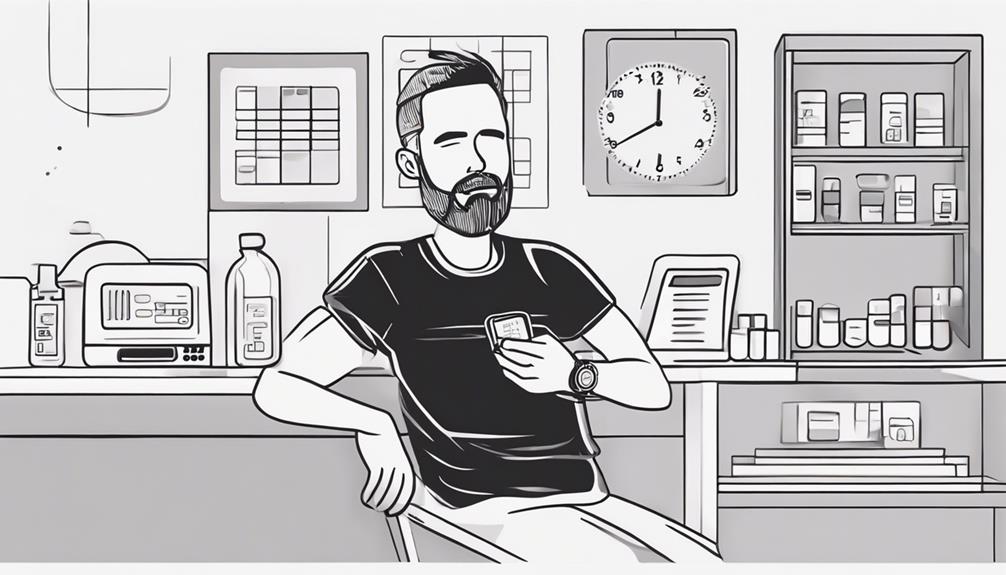Are you looking to enhance your type 1 diabetes insulin therapy regimen but unsure where to start?
Understanding the nuances of insulin therapy can be overwhelming, but fear not – with these 7 essential tips, you can navigate your treatment plan more effectively.
From mastering proper injection techniques to safely adjusting insulin doses, each tip plays a crucial role in managing your condition.
Stay tuned to uncover valuable insights that can empower you to take charge of your diabetes care and improve your overall well-being.
Key Takeaways
- Choose insulin types based on lifestyle and routine for effective management.
- Monitor blood glucose levels regularly to track body responses and patterns.
- Master proper injection techniques to ensure insulin therapy effectiveness.
- Adjust insulin doses carefully with professional guidance to maintain stable blood sugar levels.
Understanding Insulin Types

When managing type 1 diabetes, understanding the various insulin types is crucial for effective treatment. Comparing insulin options involves considering factors like onset, peak time, and duration of action.
Rapid-acting insulin, such as lispro or aspart, starts working within 15 minutes, peaks in about an hour, and lasts for 2-4 hours. On the other hand, regular insulin takes 30 minutes to start, peaks in 2-3 hours, and can last up to 6-8 hours.
Intermediate-acting insulin, like NPH, begins working in 1-2 hours, peaks in 4-12 hours, and can last up to 18 hours. Long-acting insulins, such as glargine or detemir, have a slow onset over 1-2 hours, with no pronounced peak and lasting up to 24 hours.
Choosing a regimen involves understanding your lifestyle, meal routine, and activity level to match the insulin type that best fits your needs. Working with your healthcare provider can help tailor a regimen that suits you best.
Monitoring Blood Glucose Levels
To effectively manage your type 1 diabetes, monitoring your blood glucose levels regularly is essential for maintaining optimal control of your condition. Continuous monitoring through devices like continuous glucose monitors (CGMs) can provide you with real-time data on your blood sugar levels, allowing you to make immediate adjustments to your insulin dosage or food intake. These devices offer a convenient way to track your glucose levels throughout the day and night, giving you a comprehensive view of how your body responds to different factors like exercise, stress, and meals.
In addition to continuous monitoring, frequent testing with a blood glucose meter is also crucial. Regularly checking your blood sugar levels using a meter helps you understand how your body reacts to various activities and meals. By establishing a routine of checking your blood glucose levels at different times of the day, you can identify patterns and trends, enabling you to make informed decisions about your diabetes management. Remember, staying proactive and diligent in monitoring your blood glucose levels is key to effectively managing your type 1 diabetes.
Proper Injection Techniques

For optimal management of your type 1 diabetes, mastering proper injection techniques is crucial to ensure the effectiveness of insulin therapy. Proper needle disposal is essential to prevent accidental needle sticks and infections. Always use a sharps container or a puncture-proof container to dispose of used needles safely. Never throw needles in the regular trash or recycling bin.
Injection site rotation is another key aspect of proper injection technique. Rotating injection sites helps prevent the development of lipohypertrophy, a condition where fatty lumps form under the skin due to repeated injections in the same spot. To rotate injection sites effectively, create a schedule to move around specific areas, such as the abdomen, thighs, and upper arms. Remember to record the injection sites used to keep track of rotation.
Adjusting Insulin Doses Safely
Mastering proper injection techniques is just the beginning; to ensure effective insulin therapy, it's essential to understand how to adjust insulin doses safely. When it comes to managing your diabetes, making the right dosage adjustments is crucial for maintaining stable blood sugar levels. Here are three key points to consider:
- Monitor Your Blood Sugar Levels: Regularly checking your blood sugar levels can provide valuable insights into how your body responds to insulin. By tracking these levels, you can identify patterns and trends that may indicate the need for dosage adjustments.
- Consult with Your Healthcare Provider: Before making any changes to your insulin doses, it's important to consult with your healthcare provider. They can help you determine the appropriate adjustments based on factors such as your insulin sensitivity and individual health needs.
- Gradual Changes: When adjusting your insulin doses, make changes gradually. Sudden and significant dose adjustments can lead to unpredictable blood sugar levels. By making small adjustments and monitoring the effects, you can fine-tune your insulin therapy effectively.
Managing Hypoglycemia Risks

When managing the risks of hypoglycemia in type 1 diabetes, it's crucial to carefully monitor your blood sugar levels throughout the day. Hypoglycemia, or low blood sugar, can be a serious concern for individuals with type 1 diabetes. To prevent hypoglycemia, it's essential to maintain a balanced diet, monitor your blood sugar regularly, and adjust insulin doses as needed. Always carry a fast-acting source of glucose, such as glucose tablets or gel, to quickly raise your blood sugar levels in case of an emergency.
In the event of hypoglycemia, it's important to have an emergency response plan in place. Inform those around you about the signs of low blood sugar and how they can help if you experience severe symptoms. If you're unable to treat hypoglycemia yourself, make sure your friends, family, or coworkers know how to administer glucagon in case of emergency. By staying vigilant, proactive, and prepared, you can effectively manage the risks of hypoglycemia in type 1 diabetes.
Incorporating Exercise and Diet
To effectively manage your type 1 diabetes and reduce the risks of hypoglycemia, integrating a balanced exercise regimen and healthy diet into your daily routine is essential. Here are three key tips to help you incorporate exercise and diet effectively:
- Balanced Nutrition: Opt for a diet rich in whole grains, lean proteins, fruits, vegetables, and healthy fats. Monitoring your carbohydrate intake and spacing out your meals evenly throughout the day can help stabilize blood sugar levels.
- Effective Workouts: Engage in a mix of aerobic exercises like brisk walking, cycling, or swimming, along with strength training exercises. Regular physical activity can improve insulin sensitivity, aid in weight management, and enhance overall well-being.
- Hydration: Stay well-hydrated before, during, and after exercise. Water is essential for regulating body temperature, transporting nutrients, and ensuring proper organ function. Dehydration can affect blood sugar levels and overall performance during workouts.
Seeking Professional Guidance

For comprehensive guidance on managing your type 1 diabetes effectively, consider consulting with healthcare professionals specialized in diabetes care. Consulting experts in the field of diabetes can provide you with personalized advice tailored to your specific needs. These professionals can offer valuable insights on insulin therapy, diet, exercise, and overall diabetes management strategies.
Clinical supervision from diabetes specialists is essential to ensure that your insulin therapy is optimized for your individual requirements. These experts can help you navigate the complexities of insulin dosing, timing, and adjustments based on your blood glucose levels and lifestyle factors. By seeking professional guidance, you can gain a deeper understanding of how to effectively manage your type 1 diabetes and improve your overall quality of life.
Frequently Asked Questions
Can I Mix Different Types of Insulin in the Same Injection?
You should not mix different types of insulin in the same injection. Doing so can affect the effectiveness of each type and may lead to incorrect dosages being delivered. Always consult with your healthcare provider for proper guidance.
How Often Should I Rotate Injection Sites to Prevent Lipohypertrophy?
To prevent lipohypertrophy, rotate injection sites regularly. Change spots every time you inject insulin. This helps distribute the medication evenly and reduces the risk of fat buildup. Keep your injections safe and effective.
Are There Any Specific Foods or Drinks That Can Help Prevent Hypoglycemia During Exercise?
To prevent hypoglycemia during exercise, focus on nutritional strategies. Time your snacks wisely and stay hydrated. Opt for quick carbs like fruit or juice before and during workouts. Keep glucose tabs handy for emergencies.
How Can I Safely Dispose of Used Insulin Needles and Syringes?
When disposing of used insulin needles and syringes, it's crucial to prioritize safety. Always place them in a puncture-proof container. Seal it securely. Check local guidelines for proper disposal methods. Never recycle or throw them in regular trash to protect others.
Is It Recommended to Wear a Medical Alert Bracelet for Type 1 Diabetes?
Yes, it's recommended to wear a medical alert bracelet for type 1 diabetes. It's a crucial fashion accessory that enhances emergency preparedness. Many insurance plans cover these bracelets, ensuring your safety and peace of mind.
Conclusion
In conclusion, mastering insulin therapy for type 1 diabetes requires understanding insulin types, monitoring blood glucose levels, using proper injection techniques, adjusting doses safely, managing hypoglycemia risks, incorporating exercise and diet, and seeking professional guidance.
By following these essential tips, you can better manage your diabetes and lead a healthier lifestyle. Remember, consistency and diligence are key in effectively managing your condition.
Stay informed, stay proactive, and take control of your health.